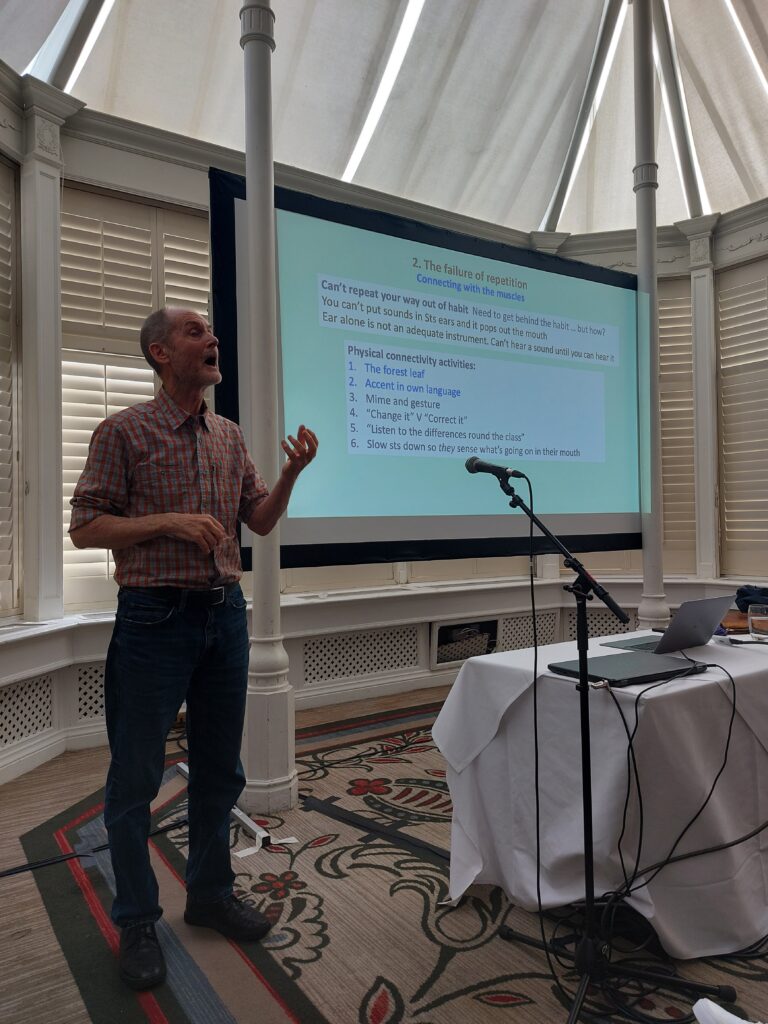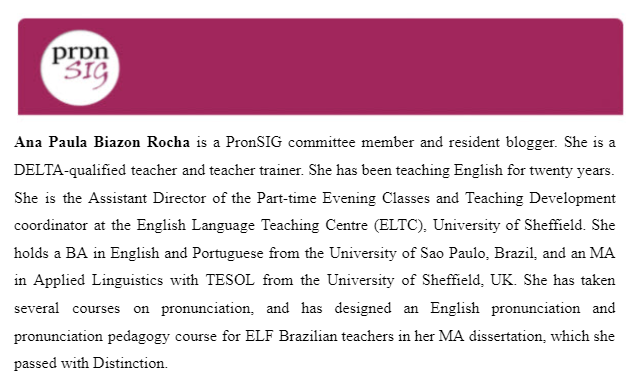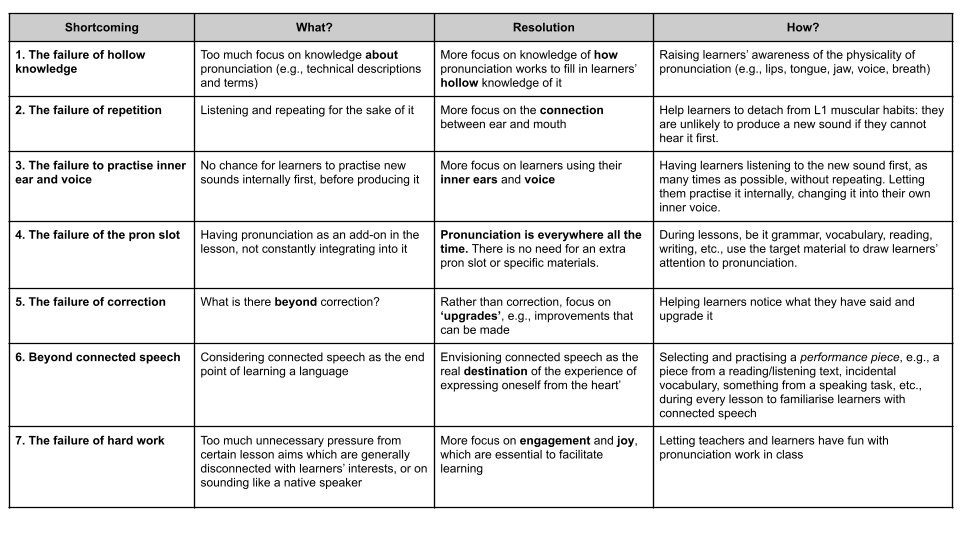by Ana Paula Biazon Rocha
At IATEFL 2024 in Brighton, Adrian Underhill, one of the most well-known names in the field of pronunciation instruction, and former PronSIG collaborator, gave a presentation entitled, ‘Seven shortcomings in pronunciation instruction and seven resolutions’, in a completely packed room, leaving everybody mesmerised and fully inspired to teach pronunciation, as usual when it comes to Underhill.
Having been there and experienced the session first hand, I thought it would be interesting to share some of his insights in this blog post, as well as listing some of his pivotal points and considering how we can extend pronunciation work in the classroom.

1. Summary of Underhill’s presentation
The main focus of Underhill’s presentation was to raise teachers’ awareness of some considerable shortcomings in pronunciation teaching that may be preventing it from being effective, and practical ways to overcome them, as summarised in the table below:
- For a PDF version of the table above, click here.
- For further details and information on Underhill’s presentation, you can read his summary of it in the latest issue of Humanising Language Teaching (June 2024, Year 26, Issue 3): ‘Seven Failures in Pronunciation Teaching, and Seven Possible Solutions’.
- For further ideas on how to use your hands to teach pronunciation, check our very first blog post.
- For a spin on the traditional ‘listen and repeat’ practice, check this previous blog post.
2. Connection between Underhill’s main points and other experts in the field
Interestingly, Underhill emphasised three crucial points in pronunciation teaching, which are also reiterated by other experts in the field:
a. Pronunciation is a physical skill such as dancing or riding a bike. It involves muscle training. Similarly, Hancock (2019) highlights that pronunciation can be categorised into four main areas: muscle, mind, meaning, and memory.
b. Pronunciation is everywhere all the time. In other words, every lesson is potentially a pronunciation lesson, as reinforced by Marks and Bowen (2012, p. 167): ‘You might never devote an entire lesson to pronunciation, but every lesson is a pronunciation lesson to some extent, because every lesson involves talking (unless it’s a writing test, perhaps) – and nobody can talk without pronouncing!’
c. Pronunciation teaching should be learner-focused. We can achieve this by acknowledging the importance and influence of learners’ L1, and by providing them with content, resources, and materials that are significant and pertinent to their lives. This is also pointed out by Brinton (2022, p. 283).
3. Extending pronunciation work
In his presentation, Underhill provided the basis for pronunciation work. If we teachers manage to avoid most of the shortcomings that he listed, and follow the resolutions that he suggested as often as possible, our learners will certainly benefit from such an effort. However, this does not mean that it is enough or that it ends there: we have the basis and we should expand it. For example, we help students practise the articulation of consonant sounds /l/ and /r/, which is usually one of the main difficulties of many Asian learners, focusing on their inner ears and voice, and then on their outer voice. We then use some minimal pair practice, e.g., long vs. wrong, alive vs. arrive, play vs. pray, etc. Is that it? Is pronunciation work done? Not really! Perhaps the next step can be some guided practice (Grant & Lyu, 2017, p. 172):
| Student A says sentence A or B: | Student B should reply accordingly: |
| a. Is it long? b. Is it wrong? | a. No, it’s short. b. No, it’s right. |
Alternatively, students can use words with both sounds, such as ‘worry’, ‘lucky’, ‘sorry’, ‘rain’, ‘train’, etc., to complete a poem, and then practise reading it aloud (Hancock, 2017, p. 38).
In this way, we are adding communicative practice to better prepare learners for real-life exchanges. For further information on how to teach pronunciation communicatively, check this previous blog post.
Finally, as you can see, there are numerous possibilities within pronunciation work in the classroom. Underhill brilliantly gave us the foundation, pun unintended with his seminal book Sound Foundations (2004), and we should then go beyond it to continue effectively engaging learners into pronunciation practice. In case you have difficulty doing this – going beyond – no worries, nobody is supposed to know everything. PronSIG is here for you!
You can check previous blog posts here. Don’t forget to leave your comments below and follow us on social media.
References
Brinton, D. M. (2022). Effective pronunciation teaching. In E. Hinkel (Ed.), Handbook of Practical Second Language Teaching and Learning (281–295). Routledge.
Grant, L. & Yu, E. E. (2017). Well Said Intro. Pronunciation for Clear Communication. Second Edition. National Geographic Learning.
Hancock, M. (2017). PronPack 4: Pronunciation Poems. Hancock McDonald ELT.
Hancock, M. (2019). Pronunciation: muscle, mind, meaning, memory. Available at http://hancockmcdonald.com/ideas/pronunciation-muscle-mind-meaning-memory . Accessed on 23 June 2024.
Hancock, M. (2019). Pronunciation: muscle, mind, meaning, memory. English Teaching Professional, 22. Available at: http://hancockmcdonald.com/ideas/pronunciation-muscle-mind-meaning-memory
Marks, J. & Bowen, T. (2012). The Book of Pronunciation. Proposals for a practical pedagogy. Delta Publishing.
Underhill, A. (2004). Sound Foundations: learning and teaching pronunciation (Revised edition.). Macmillan Education.



